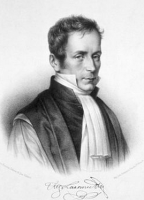










Rene-Theophile-Hyacinthe Laennec, (1781-1826), French physician who invented the stethoscope and perfected the art of auditory examination of the chest cavity.
Early Life
When Laennec was five years old, his mother, Michelle Felicite Guesdon, died from tuberculosis, leaving Laennec and his brother, Michaud, in the incompetent care of their father, Theophile-Marie Laennec, who worked as a civil servant and had a reputation for reckless spending. In 1793, during the French Revolution, Laennec went to live with his uncle, Guillaume-Francois Laennec, in the port city of Nantes, located in the Pays de la Loire region of western France. Laennec’s uncle was the dean of medicine at the University of Nantes. Although the region was in the midst of counterrevolutionary revolts, the young Laennec settled into his academic training and, under his uncle’s direction, began his medical studies. His first experience working in a hospital setting was at the Hotel-Dieu of Nantes, where he learned to apply surgical dressings and to care for patients. In 1800 Laennec went to Paris and entered the Ecole Pratique, studying anatomy and dissection in the laboratory of surgeon and pathologist Guillaume Dupuytren. Dupuytren was a bright and ambitious academic who became known for his many surgical accomplishments and for his work in alleviating permanent tissue contracture in the palm, a condition later named Dupuytren contracture. While Dupuytren undoubtedly influenced Laennec’s studies, Laennec also received instruction from other well-known French anatomists and physicians, including Gaspard Laurent Bayle, who studied tuberculosis and cancer; Marie-François-Xavier Bichat, who helped establish histology, the study of tissues; and Jean-Nicolas Corvisart des Marets, who used chest percussion to assess heart function and who served as personal physician to Napoleon I.
Laennec became known for his studies of peritonitis, amenorrhea, the prostate gland, and tubercle lesions. He graduated in 1804 and continued his research as a faculty member of the Society of the School of Medicine in Paris. He wrote several articles on pathological anatomy and became devoted to Roman Catholicism, which led to his appointment as personal physician to Joseph Cardinal Fesch, half brother of Napoleon and French ambassador to the Vatican in Rome. Laënnec remained Fesch’s physician until 1814, when the cardinal was exiled after Napoleon’s empire fell. While Laënnec’s embrace of Catholic doctrine was viewed favourably by royalists, many in the medical profession criticized his conservatism, which contradicted the views of many academicians. Nonetheless, Laënnec’s restored faith inspired him to find better ways to care for people, especially the poor. From 1812 to 1813, during the Napoleonic Wars, Laënnec took charge of the wards in the Salpêtrière Hospital in Paris, which was reserved for wounded soldiers. After the return of the monarchy, in 1816 Laënnec was appointed as physician at the Necker Hospital in Paris, where he developed the stethoscope.
Laennec’s original stethoscope design consisted of a hollow tube of wood that was 3.5 cm (1.4 inches) in diameter and 25 cm (10 inches) long and was monoaural, transmitting sound to one ear. It could be easily disassembled and reassembled, and it used a special plug to facilitate the transmission of sounds from the patient’s heart and lungs. His instrument replaced the practice of immediate auscultation, in which the physician laid his ear on the chest of the patient to listen to chest sounds. The awkwardness that this method created in the case of women patients compelled Laennec to find a better way to listen to the chest. His wooden monoaural stethoscope was replaced by models using rubber tubing at the end of the 19th century. Other advancements include the development of binaural stethoscopes, capable of transmitting sounds to both ears of the physician.
Using his own invention, he could diagnose himself and understand that he was dying.
Because Laennec’s stethoscope enabled heart and lung sounds to be heard without placing an ear on the patient’s chest, the stethoscope technique became known as the “mediate” method for auscultation. Throughout Laënnec’s medical work and research, his diagnoses were supported with observations and findings from autopsies. In addition to revolutionizing the diagnosis of lung disorders, Laënnec introduced many terms still used today. For example, Laënnec’s cirrhosis, used to describe micronodular cirrhosis (growth of small masses of tissue in the liver that cause degeneration of liver function), and melanose (Greek, meaning “black”), which he coined in 1804 to describe melanoma. Laennec was the first to recognize that melanotic lesions were the result of metastatic melanoma, in which cancer cells from the original tumour site spread to other organs and tissues in the body. He is considered the father of clinical auscultation, and he wrote the first descriptions of pneumonia, bronchiectasis, pleurisy, emphysema, and pneumothorax. His classification of pulmonary conditions is still used today.